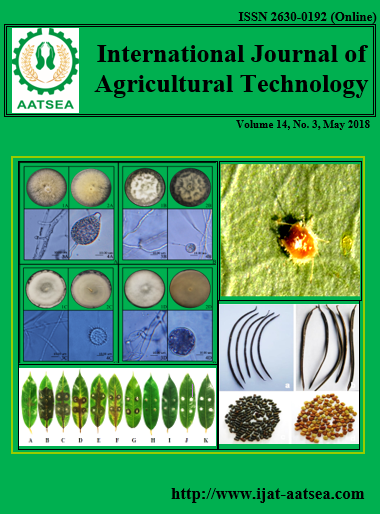Development of Extruded Ready-To-Eat Snacks from Purple Rice
Main Article Content
Abstract
The objective of this study was to investigate optimum diets for extruded snacks made from purple rice. The study was performed using a simplex-lattice mixture design. The range of three ingredients was 60-70% purple rice, 12-22% corn flour and 13-23% water equivalent for a total of 100%. Data was analyzed using ANOVA; while response surface analysis was generated using the Scheffe’s second degree polynomial. Results showed that changes in percentages of the three components significantly affected (p£0.05) sensory and physicochemical properties. Predictive models were used to plot the contour line of all sensory attributes with acceptability score greater than 5.0 being selected as optimum. Resulting overlayed contour plots indicated the most ideal diet was 70% purple rice, 12% corn flour and 18% water. Instrumental texture properties for optimum extruded snacks were composed of lightness (L*) 17.09, redness (a*) 3.09 yellowness (b*) 5.38, moisture 0.79%, water activity (aw) 0.61%, texture hardness 5.76 N. The selected diet had average score, appearance, color, flavor and overall acceptance (n = 250) in moderate levels.
Article Details

This work is licensed under a Creative Commons Attribution-NonCommercial-NoDerivatives 4.0 International License.
References
Association of Official Agricultural Chemists–AOAC (2010). International approved methods. Washington: AOAC.
Brennan, C., Brennan, M., Derbyshire, E. and Tiwari, B. K. (2011). Effects of extrusion on the Polyphenols, vitamins and antioxidant activity of foods. Trends in Food Science & Technology 22:570-575.
Chen, P., Kuo, W., Chiang, C., Chiou, H., Hsieh, Y. and Chu, S. (2006). Black rice anthocyanins inhibit cancer cells invasion via repressions of MMPs and u-PA expression. Chemico-Biological Interactions 163:218-229.
Food Institute. (2017). Market share of snack foods in 2016. Smart Center for Food Industry [online]. Sourecs of data: http://fic.nfi.or.th/Market OverviewDomestic Detail.
Jay, J. M., Loessner, M. J. and Golden, D. A. (2005). Modern food microbiology, 7th ed. Springer (India) Private Limited. pp. 443–447.
Keeratipibul, S., Luangsakul, N. and Lertsatchayarn, T. (2008). The Effect of Thai Glutinous Rice Cultivars, Grain Length and Cultivating Locations on the Quality of Rice Cracker (Arare), LWT-Food Science and Technology 41:1934-1943.
Matsuo, T, Yuzo, F., Fumio, K. and Hikoyuki, Y. (1997). Science of the rice plant. Vol. III. Genetics Tokyo (Japan): Food and Agriculture Research Center.
Mendoza, F., Dejmek, P. and Aguilera, J. M. (2007). Colour and image texture analysis classification of commercial potato chips. Food Research International 40:1146-1154.
Montgomery, D. C. (2005). Design and Analysis of Experiments, 6thed. USA: John Wiley and Sons.
Nicklas, T. A., Yang, S. J., Baranowski, T., Zakeri, I. and Berenson, G. (2003). Eating patterns and obesity in children: The Bogalusa Heart Study. American Journal of Preventive Medicine 25:9-16.
Roopa, B. S., Mazumder, P. and Bhattacharya, S. (2009). Fracture behavior and mechanism of puffed cereal during compression. Journal of Texture Studies 40:157-171.
Shimoda, H., Aitani, M., Tanaka, J. and Hitoe, S. (2015). Purple Rice Extract Exhibits Preventive Activities on Experimental Diabetes Models and Human Subjects. Rice Research 3:2-4.


